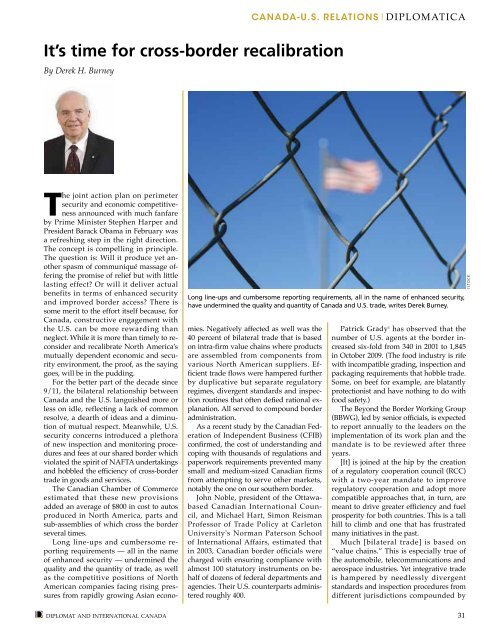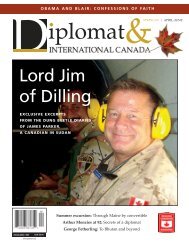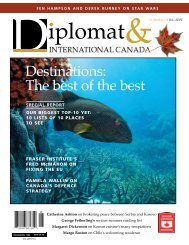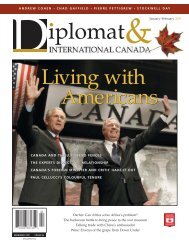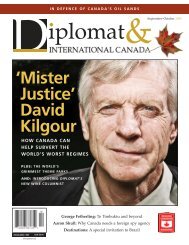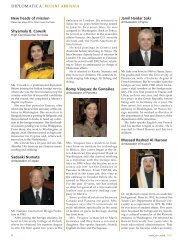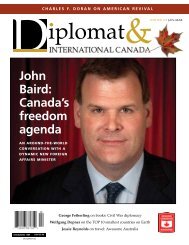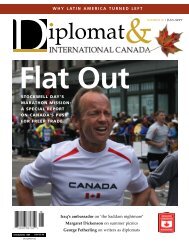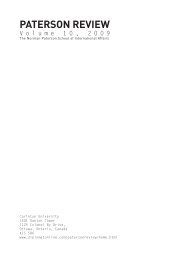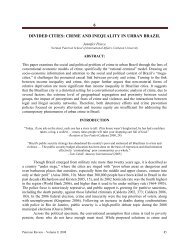the new petro power paradigm - Diplomat Magazine
the new petro power paradigm - Diplomat Magazine
the new petro power paradigm - Diplomat Magazine
Create successful ePaper yourself
Turn your PDF publications into a flip-book with our unique Google optimized e-Paper software.
It’s time for cross-border recalibration<br />
By Derek H. Burney<br />
CanadA-U.S. Relations|DIPLOMATICA<br />
diplomat and international canada<br />
Long line-ups and cumbersome reporting requirements, all in <strong>the</strong> name of enhanced security,<br />
have undermined <strong>the</strong> quality and quantity of Canada and U.S. trade, writes Derek Burney.<br />
The joint action plan on perimeter<br />
security and economic competitiveness<br />
announced with much fanfare<br />
by Prime Minister Stephen Harper and<br />
President Barack Obama in February was<br />
a refreshing step in <strong>the</strong> right direction.<br />
The concept is compelling in principle.<br />
The question is: Will it produce yet ano<strong>the</strong>r<br />
spasm of communiqué massage offering<br />
<strong>the</strong> promise of relief but with little<br />
lasting effect? Or will it deliver actual<br />
benefits in terms of enhanced security<br />
and improved border access? There is<br />
some merit to <strong>the</strong> effort itself because, for<br />
Canada, constructive engagement with<br />
<strong>the</strong> U.S. can be more rewarding than<br />
neglect. While it is more than timely to reconsider<br />
and recalibrate North America’s<br />
mutually dependent economic and security<br />
environment, <strong>the</strong> proof, as <strong>the</strong> saying<br />
goes, will be in <strong>the</strong> pudding.<br />
For <strong>the</strong> better part of <strong>the</strong> decade since<br />
9/11, <strong>the</strong> bilateral relationship between<br />
Canada and <strong>the</strong> U.S. languished more or<br />
less on idle, reflecting a lack of common<br />
resolve, a dearth of ideas and a diminution<br />
of mutual respect. Meanwhile, U.S.<br />
security concerns introduced a plethora<br />
of <strong>new</strong> inspection and monitoring procedures<br />
and fees at our shared border which<br />
violated <strong>the</strong> spirit of NAFTA undertakings<br />
and hobbled <strong>the</strong> efficiency of cross-border<br />
trade in goods and services.<br />
The Canadian Chamber of Commerce<br />
estimated that <strong>the</strong>se <strong>new</strong> provisions<br />
added an average of $800 in cost to autos<br />
produced in North America, parts and<br />
sub-assemblies of which cross <strong>the</strong> border<br />
several times.<br />
Long line-ups and cumbersome reporting<br />
requirements — all in <strong>the</strong> name<br />
of enhanced security — undermined <strong>the</strong><br />
quality and <strong>the</strong> quantity of trade, as well<br />
as <strong>the</strong> competitive positions of North<br />
American companies facing rising pressures<br />
from rapidly growing Asian economies.<br />
Negatively affected as well was <strong>the</strong><br />
40 percent of bilateral trade that is based<br />
on intra-firm value chains where products<br />
are assembled from components from<br />
various North American suppliers. Efficient<br />
trade flows were hampered fur<strong>the</strong>r<br />
by duplicative but separate regulatory<br />
regimes, divergent standards and inspection<br />
routines that often defied rational explanation.<br />
All served to compound border<br />
administration.<br />
As a recent study by <strong>the</strong> Canadian Federation<br />
of Independent Business (CFIB)<br />
confirmed, <strong>the</strong> cost of understanding and<br />
coping with thousands of regulations and<br />
paperwork requirements prevented many<br />
small and medium-sized Canadian firms<br />
from attempting to serve o<strong>the</strong>r markets,<br />
notably <strong>the</strong> one on our sou<strong>the</strong>rn border.<br />
John Noble, president of <strong>the</strong> Ottawabased<br />
Canadian International Council,<br />
and Michael Hart, Simon Reisman<br />
Professor of Trade Policy at Carleton<br />
University's Norman Paterson School<br />
of International Affairs, estimated that<br />
in 2003, Canadian border officials were<br />
charged with ensuring compliance with<br />
almost 100 statutory instruments on behalf<br />
of dozens of federal departments and<br />
agencies. Their U.S. counterparts administered<br />
roughly 400.<br />
Patrick Grady 1 has observed that <strong>the</strong><br />
number of U.S. agents at <strong>the</strong> border increased<br />
six-fold from 340 in 2001 to 1,845<br />
in October 2009. (The food industry is rife<br />
with incompatible grading, inspection and<br />
packaging requirements that hobble trade.<br />
Some, on beef for example, are blatantly<br />
protectionist and have nothing to do with<br />
food safety.)<br />
The Beyond <strong>the</strong> Border Working Group<br />
(BBWG), led by senior officials, is expected<br />
to report annually to <strong>the</strong> leaders on <strong>the</strong><br />
implementation of its work plan and <strong>the</strong><br />
mandate is to be reviewed after three<br />
years.<br />
[It] is joined at <strong>the</strong> hip by <strong>the</strong> creation<br />
of a regulatory cooperation council (RCC)<br />
with a two-year mandate to improve<br />
regulatory cooperation and adopt more<br />
compatible approaches that, in turn, are<br />
meant to drive greater efficiency and fuel<br />
prosperity for both countries. This is a tall<br />
hill to climb and one that has frustrated<br />
many initiatives in <strong>the</strong> past.<br />
Much [bilateral trade] is based on<br />
“value chains.” This is especially true of<br />
<strong>the</strong> automobile, telecommunications and<br />
aerospace industries. Yet integrative trade<br />
is hampered by needlessly divergent<br />
standards and inspection procedures from<br />
different jurisdictions compounded by<br />
31<br />
istock


